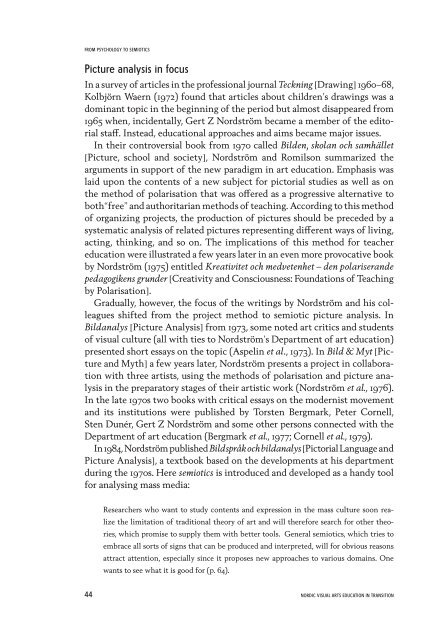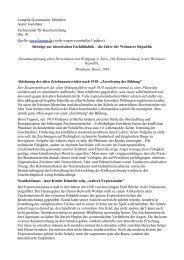Research in Visual Arts Education - The National Society for ...
Research in Visual Arts Education - The National Society for ...
Research in Visual Arts Education - The National Society for ...
You also want an ePaper? Increase the reach of your titles
YUMPU automatically turns print PDFs into web optimized ePapers that Google loves.
FROM PSYCHOLOGY TO SEMIOTICS<br />
Picture analysis <strong>in</strong> focus<br />
In a survey of articles <strong>in</strong> the professional journal Teckn<strong>in</strong>g [Draw<strong>in</strong>g] 1960–68,<br />
Kolbjörn Waern (1972) found that articles about children’s draw<strong>in</strong>gs was a<br />
dom<strong>in</strong>ant topic <strong>in</strong> the beg<strong>in</strong> n<strong>in</strong>g of the period but almost disappeared from<br />
1965 when, <strong>in</strong>cidentally, Gert Z Nord ström became a member of the editorial<br />
staff. Instead, educational approaches and aims became major issues.<br />
In their controversial book from 1970 called Bilden, skolan och samhället<br />
[Picture, school and society], Nordström and Romilson summarized the<br />
arguments <strong>in</strong> support of the new paradigm <strong>in</strong> art education. Emphasis was<br />
laid upon the contents of a new subject <strong>for</strong> pictorial studies as well as on<br />
the method of polarisation that was offered as a pro gressive alternative to<br />
both“free” and authoritarian methods of teach<strong>in</strong>g. Accord<strong>in</strong>g to this method<br />
of organiz<strong>in</strong>g projects, the production of pictures should be preceded by a<br />
system atic analysis of related pictures represent<strong>in</strong>g different ways of liv<strong>in</strong>g,<br />
act<strong>in</strong>g, th<strong>in</strong>k <strong>in</strong>g, and so on. <strong>The</strong> implications of this method <strong>for</strong> teacher<br />
education were illustrated a few years later <strong>in</strong> an even more provocative book<br />
by Nord ström (1975) entitled Kreativitet och med vetenhet – den polariserande<br />
pedagogikens grunder [Creativity and Consciousness: Founda tions of Teach<strong>in</strong>g<br />
by Polarisation].<br />
Gradually, however, the focus of the writ<strong>in</strong>gs by Nordström and his colleagues<br />
shifted from the project method to semiotic picture analysis. In<br />
Bildanalys [Picture Analysis] from 1973, some noted art critics and students<br />
of visual culture (all with ties to Nordström’s Depart ment of art education)<br />
presented short essays on the topic (Aspel<strong>in</strong> et al., 1973). In Bild & Myt [Picture<br />
and Myth] a few years later, Nordström presents a project <strong>in</strong> collaboration<br />
with three artists, us<strong>in</strong>g the methods of polarisation and picture analysis<br />
<strong>in</strong> the preparatory stages of their artistic work (Nordström et al., 1976).<br />
In the late 1970s two books with critical essays on the modernist movement<br />
and its <strong>in</strong>stitutions were published by Torsten Bergmark, Peter Cornell,<br />
Sten Dunér, Gert Z Nordström and some other persons connected with the<br />
Depart ment of art education (Bergmark et al., 1977; Cornell et al., 1979).<br />
In 1984, Nordström published Bildspråk och bildanalys [Pictorial Language and<br />
Picture Analysis], a textbook based on the developments at his department<br />
dur<strong>in</strong>g the 1970s. Here semiotics is <strong>in</strong>troduced and developed as a handy tool<br />
<strong>for</strong> analys<strong>in</strong>g mass media:<br />
<strong>Research</strong>ers who want to study contents and expression <strong>in</strong> the mass culture soon realize<br />
the limitation of traditional theory of art and will there<strong>for</strong>e search <strong>for</strong> other theories,<br />
which promise to supply them with better tools. General semiotics, which tries to<br />
embrace all sorts of signs that can be produced and <strong>in</strong>terpreted, will <strong>for</strong> obvious reasons<br />
attract attention, especially s<strong>in</strong>ce it proposes new approaches to various doma<strong>in</strong>s. One<br />
wants to see what it is good <strong>for</strong> (p. 64).<br />
44 NORDIC VISUAL ARTS EDUCATION IN TRANSITION



